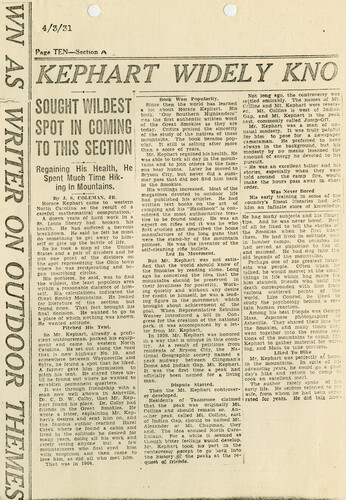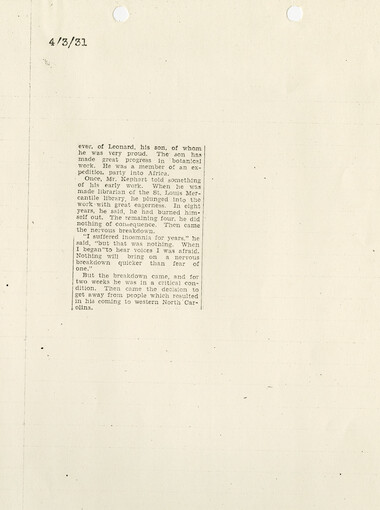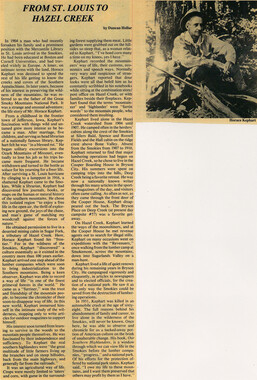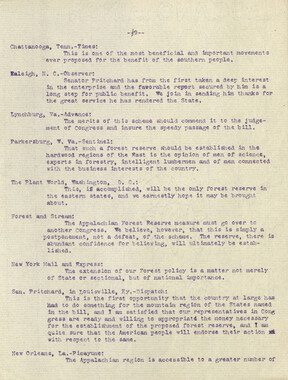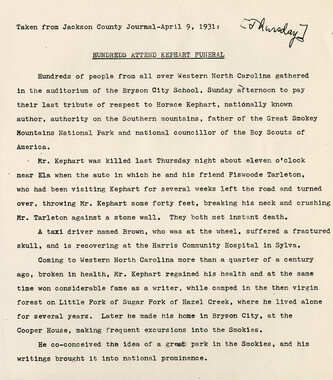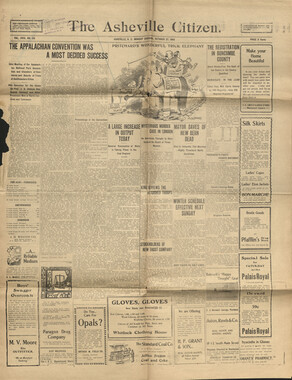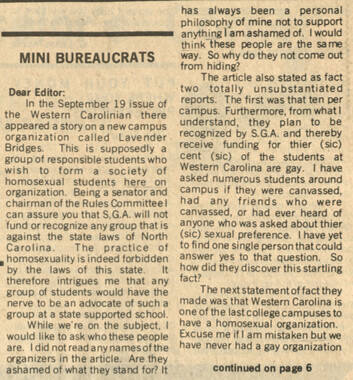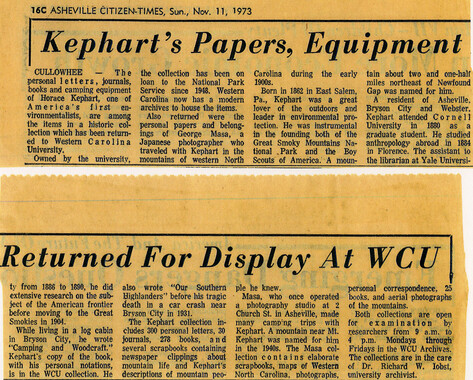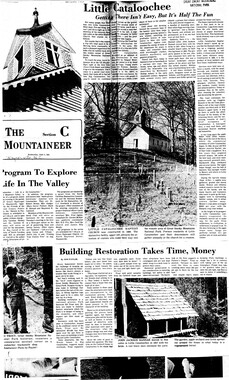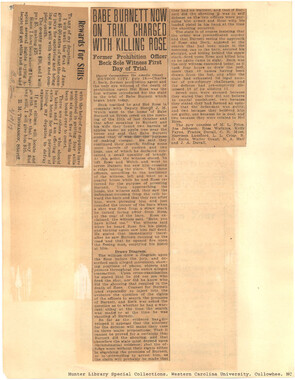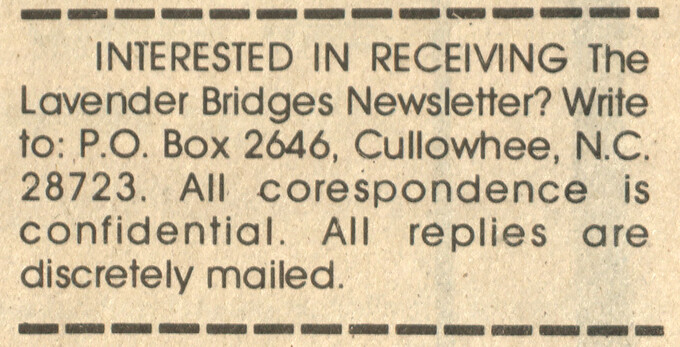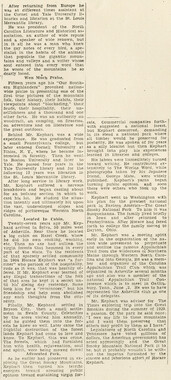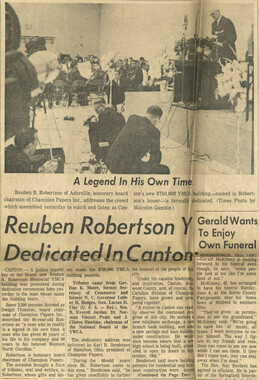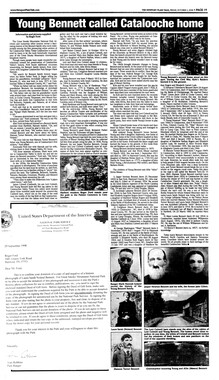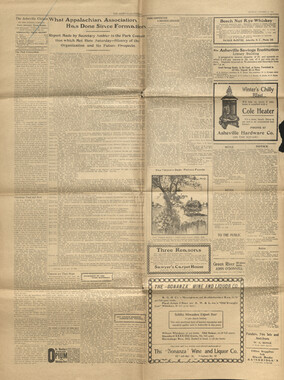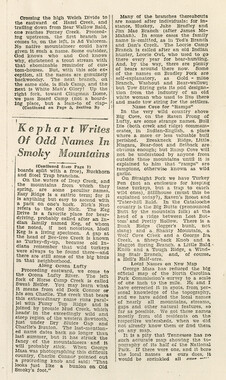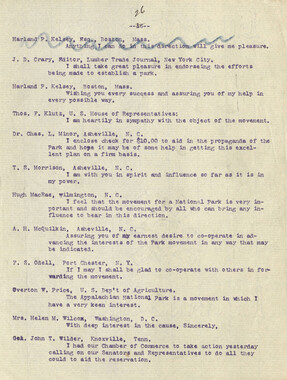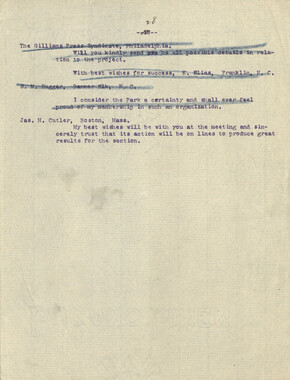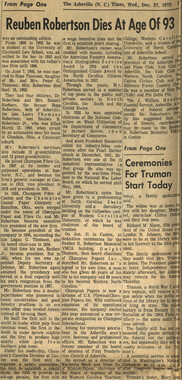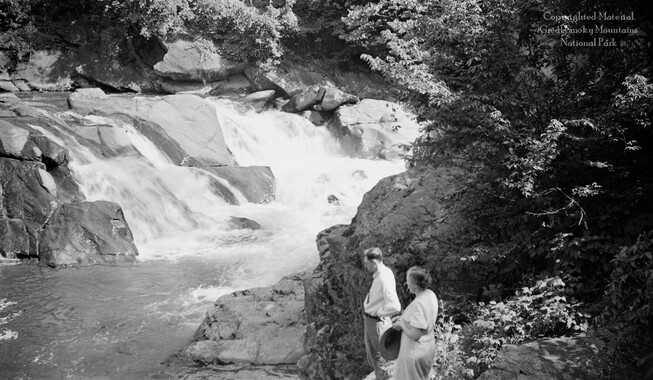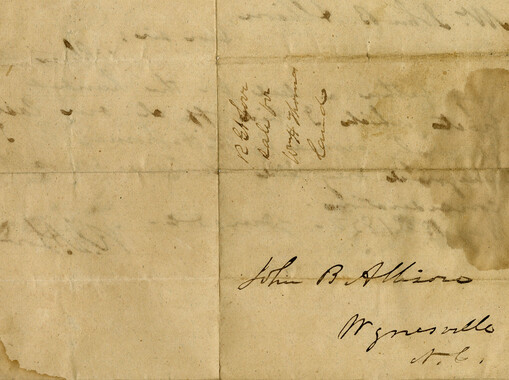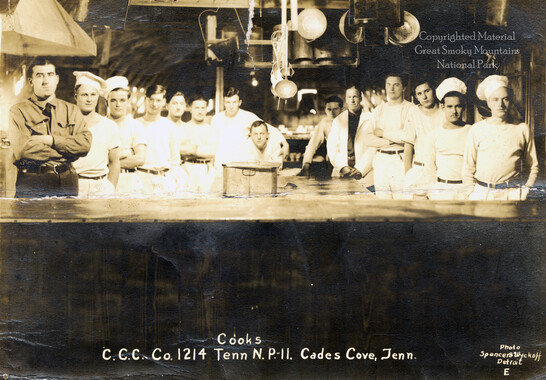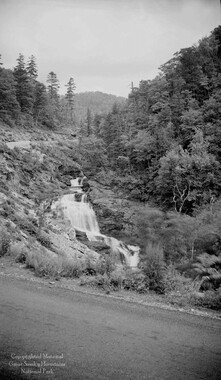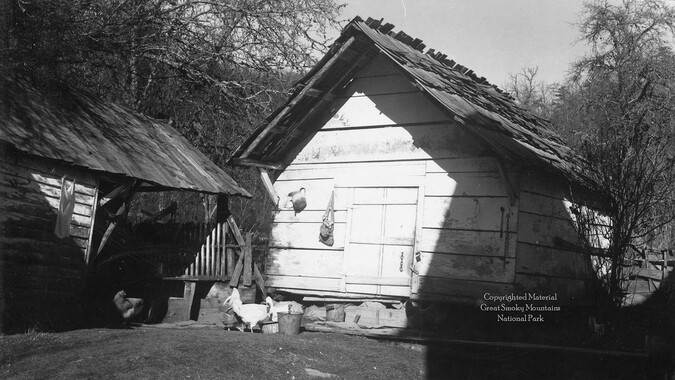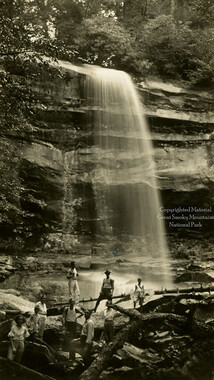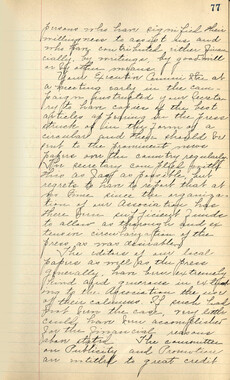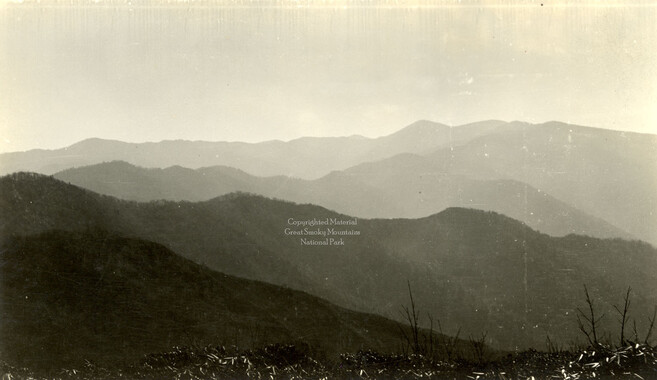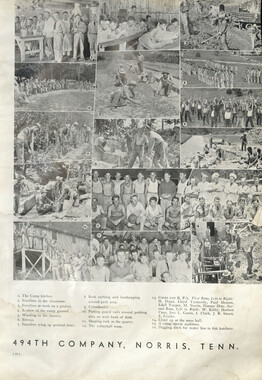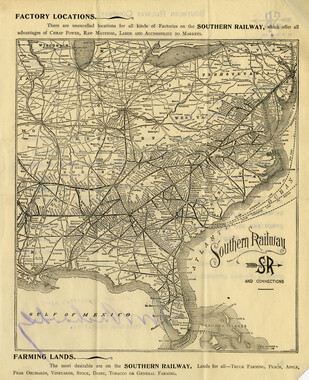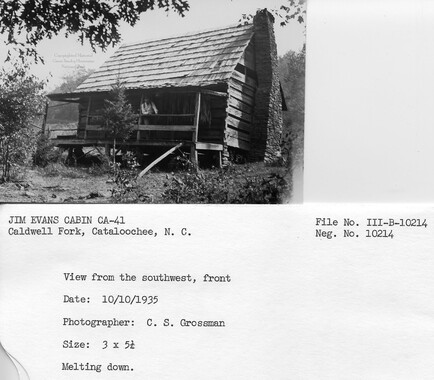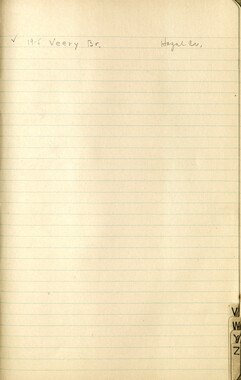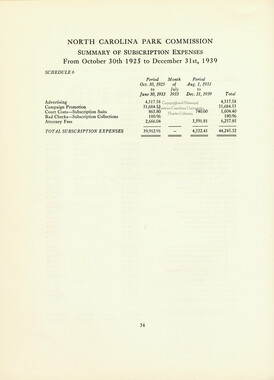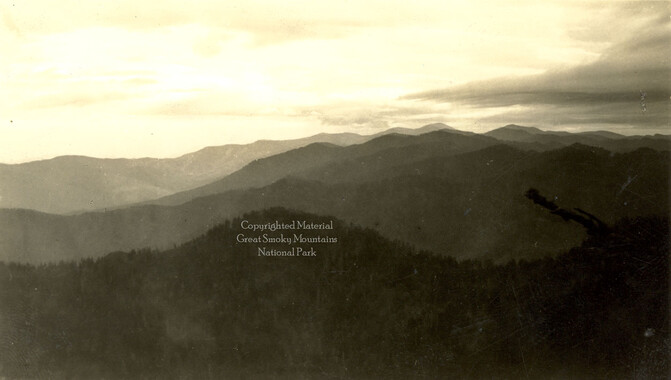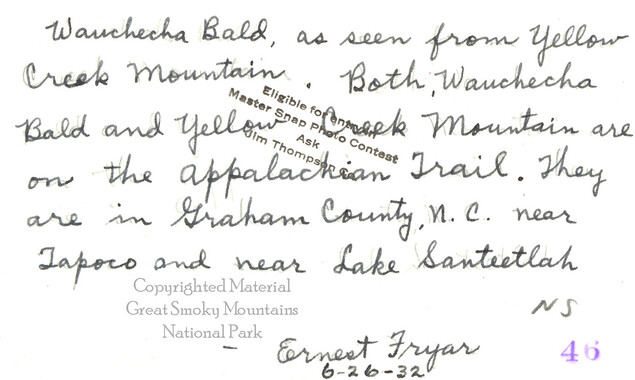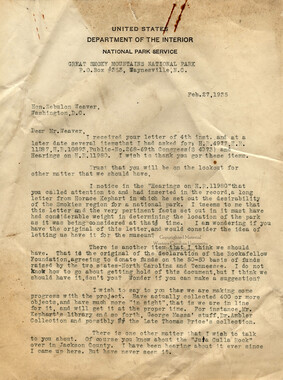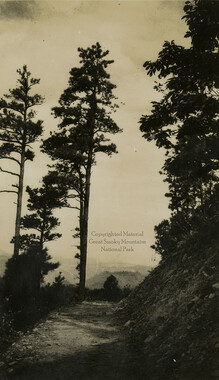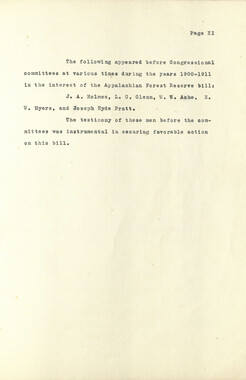Western Carolina University (20)
View all
- Canton Champion Fibre Company (2308)
- Cherokee Traditions (293)
- Civil War in Southern Appalachia (165)
- Craft Revival (1942)
- Great Smoky Mountains - A Park for America (2767)
- Highlights from Western Carolina University (430)
- Horace Kephart (941)
- Journeys Through Jackson (154)
- LGBTQIA+ Archive of Jackson County (19)
- Oral Histories of Western North Carolina (314)
- Picturing Appalachia (6679)
- Stories of Mountain Folk (413)
- Travel Western North Carolina (160)
- Western Carolina University Fine Art Museum Vitreograph Collection (129)
- Western Carolina University Herbarium (92)
- Western Carolina University: Making Memories (708)
- Western Carolina University Publications (2283)
- Western Carolina University Restricted Electronic Theses and Dissertations (146)
- Western North Carolina Regional Maps (71)
- World War II in Southern Appalachia (131)
University of North Carolina Asheville (6)
View all
- Allanstand Cottage Industries (62)
- Appalachian National Park Association (53)
- Bennett, Kelly, 1890-1974 (1295)
- Berry, Walter (76)
- Brasstown Carvers (40)
- Carver, George Washington, 1864?-1943 (26)
- Cathey, Joseph, 1803-1874 (1)
- Champion Fibre Company (233)
- Champion Paper and Fibre Company (297)
- Cherokee Indian Fair Association (16)
- Cherokee Language Program (22)
- Crowe, Amanda (40)
- Edmonston, Thomas Benton, 1842-1907 (7)
- Ensley, A. L. (Abraham Lincoln), 1865-1948 (275)
- Fromer, Irving Rhodes, 1913-1994 (70)
- George Butz (BFS 1907) (46)
- Goodrich, Frances Louisa (120)
- Grant, George Alexander, 1891-1964 (96)
- Heard, Marian Gladys (60)
- Kephart, Calvin, 1883-1969 (15)
- Kephart, Horace, 1862-1931 (313)
- Kephart, Laura, 1862-1954 (39)
- Laney, Gideon Thomas, 1889-1976 (439)
- Masa, George, 1881-1933 (61)
- McElhinney, William Julian, 1896-1953 (44)
- Niggli, Josephina, 1910-1983 (10)
- North Carolina Park Commission (105)
- Osborne, Kezia Stradley (9)
- Owens, Samuel Robert, 1918-1995 (11)
- Penland Weavers and Potters (36)
- Roberts, Vivienne (15)
- Roth, Albert, 1890-1974 (142)
- Schenck, Carl Alwin, 1868-1955 (1)
- Sherrill's Photography Studio (2565)
- Southern Highland Handicraft Guild (127)
- Southern Highlanders, Inc. (71)
- Stalcup, Jesse Bryson (46)
- Stearns, I. K. (213)
- Thompson, James Edward, 1880-1976 (226)
- United States. Indian Arts and Crafts Board (130)
- USFS (683)
- Vance, Zebulon Baird, 1830-1894 (1)
- Weaver, Zebulon, 1872-1948 (58)
- Western Carolina College (230)
- Western Carolina Teachers College (282)
- Western Carolina University (1794)
- Western Carolina University. Mountain Heritage Center (18)
- Whitman, Walt, 1819-1892 (10)
- Wilburn, Hiram Coleman, 1880-1967 (73)
- Williams, Isadora (3)
- Cain, Doreyl Ammons (0)
- Crittenden, Lorraine (0)
- Rhodes, Judy (0)
- Smith, Edward Clark (0)
- Appalachian Region, Southern (2393)
- Asheville (N.C.) (1886)
- Avery County (N.C.) (26)
- Blount County (Tenn.) (161)
- Buncombe County (N.C.) (1664)
- Cherokee County (N.C.) (283)
- Clay County (N.C.) (555)
- Graham County (N.C.) (233)
- Great Smoky Mountains National Park (N.C. and Tenn.) (478)
- Haywood County (N.C.) (3522)
- Henderson County (N.C.) (70)
- Jackson County (N.C.) (4692)
- Knox County (Tenn.) (25)
- Knoxville (Tenn.) (12)
- Lake Santeetlah (N.C.) (10)
- Macon County (N.C.) (420)
- Madison County (N.C.) (211)
- McDowell County (N.C.) (39)
- Mitchell County (N.C.) (132)
- Polk County (N.C.) (35)
- Qualla Boundary (981)
- Rutherford County (N.C.) (76)
- Swain County (N.C.) (2020)
- Transylvania County (N.C.) (247)
- Watauga County (N.C.) (12)
- Waynesville (N.C.) (68)
- Yancey County (N.C.) (72)
- Aerial Photographs (3)
- Aerial Views (60)
- Albums (books) (4)
- Articles (1)
- Artifacts (object Genre) (228)
- Biography (general Genre) (2)
- Cards (information Artifacts) (38)
- Clippings (information Artifacts) (191)
- Crafts (art Genres) (622)
- Depictions (visual Works) (21)
- Design Drawings (1)
- Drawings (visual Works) (184)
- Envelopes (73)
- Facsimiles (reproductions) (1)
- Fiction (general Genre) (4)
- Financial Records (12)
- Fliers (printed Matter) (67)
- Glass Plate Negatives (381)
- Guidebooks (2)
- Internegatives (10)
- Interviews (811)
- Land Surveys (102)
- Letters (correspondence) (1013)
- Manuscripts (documents) (619)
- Maps (documents) (159)
- Memorandums (25)
- Minutes (administrative Records) (59)
- Negatives (photographs) (5735)
- Newsletters (1285)
- Newspapers (2)
- Occupation Currency (1)
- Paintings (visual Works) (1)
- Pen And Ink Drawings (1)
- Periodicals (193)
- Personal Narratives (7)
- Photographs (12982)
- Plans (maps) (1)
- Poetry (5)
- Portraits (1657)
- Postcards (329)
- Programs (documents) (151)
- Publications (documents) (2237)
- Questionnaires (65)
- Scrapbooks (282)
- Sheet Music (1)
- Slides (photographs) (402)
- Sound Recordings (796)
- Specimens (92)
- Speeches (documents) (15)
- Tintypes (photographs) (8)
- Transcripts (322)
- Video Recordings (physical Artifacts) (23)
- Vitreographs (129)
- Text Messages (0)
- A.L. Ensley Collection (275)
- Appalachian Industrial School Records (7)
- Appalachian National Park Association Records (336)
- Axley-Meroney Collection (2)
- Bayard Wootten Photograph Collection (20)
- Bethel Rural Community Organization Collection (7)
- Blumer Collection (5)
- C.W. Slagle Collection (20)
- Canton Area Historical Museum (2110)
- Carlos C. Campbell Collection (282)
- Cataloochee History Project (65)
- Cherokee Studies Collection (4)
- Daisy Dame Photograph Album (5)
- Daniel Boone VI Collection (1)
- Doris Ulmann Photograph Collection (112)
- Elizabeth H. Lasley Collection (1)
- Elizabeth Woolworth Szold Fleharty Collection (4)
- Frank Fry Collection (95)
- George Masa Collection (173)
- Gideon Laney Collection (452)
- Hazel Scarborough Collection (2)
- Hiram C. Wilburn Papers (28)
- Historic Photographs Collection (236)
- Horace Kephart Collection (861)
- Humbard Collection (33)
- Hunter and Weaver Families Collection (1)
- I. D. Blumenthal Collection (4)
- Isadora Williams Collection (4)
- Jesse Bryson Stalcup Collection (47)
- Jim Thompson Collection (224)
- John B. Battle Collection (7)
- John C. Campbell Folk School Records (80)
- John Parris Collection (6)
- Judaculla Rock project (2)
- Kelly Bennett Collection (1314)
- Love Family Papers (11)
- Major Wiley Parris Civil War Letters (3)
- Map Collection (12)
- McFee-Misemer Civil War Letters (34)
- Mountain Heritage Center Collection (4)
- Norburn - Robertson - Thomson Families Collection (44)
- Pauline Hood Collection (7)
- Pre-Guild Collection (2)
- Qualla Arts and Crafts Mutual Collection (12)
- R.A. Romanes Collection (681)
- Rosser H. Taylor Collection (1)
- Samuel Robert Owens Collection (94)
- Sara Madison Collection (144)
- Sherrill Studio Photo Collection (2558)
- Smoky Mountains Hiking Club Collection (616)
- Stories of Mountain Folk - Radio Programs (374)
- The Reporter, Western Carolina University (510)
- Venoy and Elizabeth Reed Collection (16)
- WCU Gender and Sexuality Oral History Project (32)
- WCU Mountain Heritage Center Oral Histories (25)
- WCU Oral History Collection - Mountain People, Mountain Lives (71)
- WCU Students Newspapers Collection (1744)
- Western North Carolina Tomorrow Black Oral History Project (69)
- William Williams Stringfield Collection (2)
- Zebulon Weaver Collection (109)
- African Americans (388)
- Appalachian Trail (35)
- Artisans (521)
- Cherokee art (84)
- Cherokee artists -- North Carolina (10)
- Cherokee language (21)
- Cherokee pottery (101)
- Cherokee women (208)
- Church buildings (166)
- Civilian Conservation Corps (U.S.) (110)
- College student newspapers and periodicals (1830)
- Dams (95)
- Dance (1023)
- Education (222)
- Floods (60)
- Folk music (1015)
- Forced removal, 1813-1903 (2)
- Forest conservation (220)
- Forests and forestry (917)
- Gender nonconformity (4)
- Great Smoky Mountains National Park (N.C. and Tenn.) (154)
- Hunting (38)
- Landscape photography (10)
- Logging (103)
- Maps (84)
- Mines and mineral resources (8)
- North Carolina -- Maps (18)
- Paper industry (38)
- Postcards (255)
- Pottery (135)
- Railroad trains (69)
- Rural electrification -- North Carolina, Western (3)
- School integration -- Southern States (2)
- Segregation -- North Carolina, Western (5)
- Slavery (5)
- Sports (452)
- Storytelling (245)
- Waterfalls -- Great Smoky Mountains (N.C. and Tenn.) (66)
- Weaving -- Appalachian Region, Southern (280)
- Wood-carving -- Appalachian Region, Southern (328)
- World War, 1939-1945 (173)
Kephart widely known as writer on outdoor themes
Item
Item’s are ‘child’ level descriptions to ‘parent’ objects, (e.g. one page of a whole book).
-
-
4/3/31 Page TEN-—Section fK V*f A*""''* /'" M J? « SHT WILDEST' SPOT IN GOMlrr1 Regaining His Health, He j Spent Much Time Hiking In Mountains. By .1. S. COLEMAN, -IK. Horace Kephart came to western North Carolina as the result of a careful mathematical computation, i A dozen years of hard work in a St. Louis library had broken his health. He had suffered a nervous breakdown. He said he felt he must do something to get away to himself or give up the battle of life. So he took a map of the United States and a pair of dividers and he put one point of the dividers on the spot representing the Ohio town where he was recuperating and began inscribing circles. His problem, he said, was to find the wildest, the least populous area within a reasonable distance of himself. His calculations indicated the Great Smoky Mountains. Hs looked for literature of the section but found none. That fact brought his final decision. He wanted to go to a place of which nothing was known. He wanted solitude. Pitched His Tent. So Mr. Kephart, already a proficient outdoorsman, packed his equipment ?nd came to western North ' Carolina. He set, out along the road that is now highway No. 10. and somewhere between Waynesvllle and Sylva, he found a spot that he liked. ■ a" farmer gave him permission to pitch his tent. He stayed there un- | til he found out where he wanted to ; establish permanent quarters. It was through friendship with a j man now well known in Asheville. j Dr. C. D. W. Colby, that Mr. Kep- hart found his place. Dr. Colby had friends in the Great Smokies. He I wrote a letter, explaining Mr. Kephart's desires and sent him on, and the famous author reached Hazel Creek where he found a cabin and lived in the solitude he desired for many years, doing all his work and rarely seeing anyone but a few -mountaineers who first eyed him with suspicion and then came to love him, as did all who met him. That was in 1904. Book Won Popularity. Since then the world has learned a lot about Horace Kephart. His book. "Our Southern Highlanders" was the first authentic written word of the Great Smokies as they are today. Critics praised the sincerity of the study of ths natives of these mountains. The book became popular. It still is selling after more than a score of years. Mr. Kephart regained his health. He was able to trek all day in the mountains and to join others in the famous bear hunts. Later he moved to Bryson City, but never did a summer pass that did not find him back in the Smokies. His writings increased. Most of the magazines devoted to outdoor life had published his articles. He had written text books on the art of camping and his "Handbook" is considered the most authoritative treatise to be found today. He was an expert on rifles and it was he who first studied and described the home manufacture of the long guns that were the stand-by of the mountain pioneer. He was the inventor of the self-cleaning rifle bullets. Led In Movement. But Mr. Kephart was not satisfied that the world should know of the Smokies by reading alone. Long ago he conceived the idea that the mountains should be preserved in their loveliness for posterity. Working quietly and without any desire for credit to himself, he was a leading figure in the movement which brought about achievement of the goal. When Representative Zebulon Weaver introduced a bill in Congress for the creation of the national park, it was accompanied by a letter from Mr. Kephart. In 1928. Mr. Kephart was honored in a way that is unique in this country. As a result of petitions from residents of Bryson City, the National Geographic society named a peak midway between Clingman's Dome and Indian Gap, Mt, Kephart. It was the first time a peak had officially been named for a living man. Dispute Started. Then the Mt. Kephart controver- sv developed. Residents of Tennessee claimed that the peak was originally Mt. Collins and should remain so. Another peak, called Mt. Collins, east of Indian Gap, should be nai'ned Mt. Alexander or Mt. Chapman, they said. The idea aroused North Carolinians. For a while it seemed as though bitter feelings would develop. Mr. Kephart took as part in the contnovej&y »5»c*pt to go back into the history *ft the peaks at the request oC JriMKSs. Not long ago, the controversy was j settled amicably. The names of Mt. \ Collins and Mt, Kephart were revers- ; ed. Mt. Collins is west of Indian Gap, and Mt. Kephart is the peak ; cast, commonly called Jump-Off. Mr. Kephart was a man of unusual modesty. It was truly painful for him to pose for a newspaper cameraman. He preferred to keep always in the background, but his modesty by no means lessened the s mount of energy he devoted to his pursuit. -- He was an excellent talker and his stories, especially when they were told around the camp fire, would make the hours pass away In short j order. Was Never Bored His early training in some of the country's finest libraries had left him an infinite store of knowledge, j He had many subjects and his fingei tips. And he was never bored- Best of all he liked to tell the stories o" the Smokies when he first knew them. He had lived in solitude, and in lumber camps. On occasion he . had served, as physician to the ill and maimed. He had dug into the j old legends of the mountains. Perhaps one of his greatest interests was people. Often when 1 talked, he would marvel at the small things in life which had made for him staunch friends who until his death corresponded with him from various scattered point.-, of the world. Like Conrad, he liked to study the psychology behind a certain human reaction. Among his best friends was George Masa. Japanese photographer of Asheville. They shared their love for the Smokies, and many times they went together into the remote sections of the mountains to camp, Mr. Kephart to gather material for writ-., lng, and Masa to take pictures. Liked To Hike Mr. Kephart was perfectly at home- in the mountains. In spite of hii advancing years, he could do a good day's hike and return to camp to cook an excellent meal. The author rarely spoke or I I early life. He seldom referred tc ri wife, from whom he had been sepa- i rated for years. He did talk how - a^^.j-rvttr.iaiv^'.M.AMjm.WTi^fe^
Object
Object’s are ‘parent’ level descriptions to ‘children’ items, (e.g. a book with pages).
-
This article is a memorial to Horace Kephart (1862-1931), a noted naturalist, woodsman, journalist, and author. In 1904, he left his work as a librarian in St. Louis and permanently moved to western North Carolina. His popular book, “Camping and Woodcraft” was first published 1906; the 1916/1917 edition is considered a standard manual for campers after almost a century of use. Living and working in a cabin on Hazel Creek in Swain County, Kephart began to document life in the Great Smoky Mountains, producing “Our Southern Highlanders” in 1913. Throughout his life, Kephart wrote many articles supporting the Great Smoky Mountains National Park.
-

